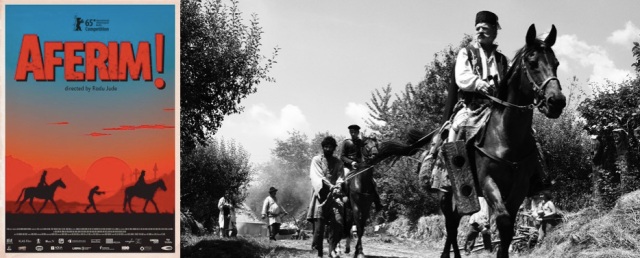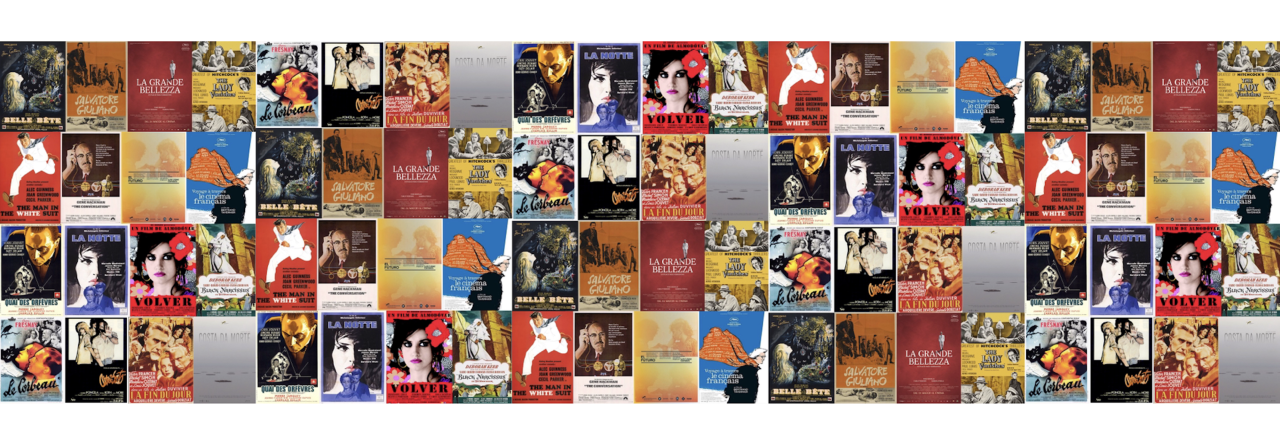
This is now the longest that I’ve stayed at a given festival and I’m at that stage where time has become elongated – my days of the week are all mixed up and I’m finding it hard to judge where I am in the day itself.

Anyway, according to my notebook it was on day 5 that I saw Aferim! (Radu Jude, 2015) – another of the competition titles, and one of my favourites of the festival so far. If I had to classify it, I’d go for ‘picaresque Western’ with touches of Don Quijote. Set in the Romania of 1835, the film follows the adventures of father and son police constables Constandin (Teodor Corban) and Ionita (Mihai Comanoiu) as they pursue an escaped Gypsy slave (Carfin – played by Toma Cuzin) who is accused of stealing money from the local lord. With satirical touches – and no end of idioms, courtesy of Constandin’s fondness for folkloric sayings – the dialogue reveals xenophobia, racism, class strife and feudal injustices to be endemic to the time (of course, this can also be taken as commentary on the present as well). Even while the characters are conscious of these injustices (Constandin and Ionita discover that the situation with Carfin is not quite what they’ve been told – and Ionita goes as far as to suggest that they should pretend that they can’t find him because they know that he’s not guilty of the crime he’s accused of), they nonetheless feel that they can do nothing to change them (“The world will stay as it is, and you can’t change it”). The film is laced with humour and shot in a crisp black and white utilising the varied Romanian landscape as if viewed by John Ford – it just feels as if you’re in the hands of a director who has something to say and knows how he wants to say it. Recommended.

Next I went to see an exhibition of photographs of Mexico by Luis Buñuel. He shot twenty films in Mexico, from Gran Casino (1947) to Simon of the Desert (1965), which amounts to almost two thirds of his filmography. The photos seem to have been taken while he was scouting for locations – the exhibition indicates which film they relate to and uses a still from the film to show how they appeared onscreen – and serve as an illustration of his eye for detail and exhaustive preparation. I thought that the next event was a roundtable discussion with the other Convergencias participants, but it turned out that I’d misunderstood – we were interviewed on camera (en español, claro) by TCM/Telecable about our choice of film and what else we’d seen at the festival that we’d recommend. I haven’t watched the video yet, but I’ll post a link within this post when I have (provided I haven’t made an arse of myself).

Next was the fourth of the Convergencias titles – Os olhos de André / André’s Eyes (Antonio Borges Correia, 2015), a Portuguese film chosen by Jesús Choya (you can read Jesús’s text on the film, here). Jesús is the youngest of the participants (he is only 16) and I was really impressed by how articulate he was in explaining his choice of film during the interview earlier in the day – that, in combination with the fact that the film had also been recommended to me by a friend, meant that I was keen to see this one. The film tells the story of a single father and his sons, the youngest of whom has been taken into care after their estranged mother raised a question about the child’s paternity. The story is ‘performed’ (probably better to say ‘recreated’) by the actual family involved – apart from the mother, everyone in the film is essentially playing themselves. It feels like a very honest film without any artificial constructions, and it is impactful in an emotional sense because you watch events that are obviously traumatic for a family, being re-lived. I know that the film is on Festival Scope, so I’m intending to rewatch it when I get home – I may return to it on here at a later date.

The last film of the day for me was The Thoughts That Once We Had (Thom Andersen, 2015) – an essay film that the opening titles tell us is ‘a personal history’ of cinema but refracted through Gilles Deleuze’s book The Movement-Image (1986). I loved the journey through cinema and the juxtapositions making connections (or illustrating evolutions) across different eras and cinemas, but for me there was too much Theory (with a capital ‘T’). It may have been the lateness of the hour, but I found it difficult to assimilate and process the numerous quotations from the book with sufficient speed to make my own connections with the images (and to personally join the dots between words and image). I’d watch it again (for the clips above all) although I’d probably prefer to do so in a format where I could pause it and think the ideas through as I went along.

I spent Wednesday morning writing the previous one of these posts (I’m trying to write them regularly, otherwise I end up with a glut of stuff to write up at the end – also, writing just a paragraph on each film seems to be a good way to fix it in my mind). So the first film of the day for me was another of the competition titles – Black (Adil El Arbi and Bilall Fallah, 2015), a Belgian production and adaptation of two novels by Dirk Bracke. The film is effectively a contemporary Romeo and Juliet within the world of rival urban gangs – and also a commentary on the experience of immigrants and first-generation nationals in Belgium, because the gangs are Sub-Saharan African and Moroccan in origin. Mavela (Martha Canga Antonio) and Marwan (Aboubakr Bensaihi) fall in love after a chance encounter at the police station (both have been arrested for theft) and begin a clandestine relationship that puts them in danger with their respective gangs. I have some issues with the depiction of sexual violence against women within the film (the female characters are treated like meat by the males). For me, the opening sequence, where we intuit that a woman is being sexually assaulted through the combination of screams and abstract patterns of colour, movement and light that are seen through glass (we cannot explicitly see the event itself), was a more imaginative representation than a later assault when a female character is stripped and effectively put on display for the camera as well as her attackers. It could perhaps be argued that that is in keeping with how the men who are present view her but I get a bit fed up with women being filmed in traumatic situations in that way. However that issue aside, the film has a lot to commend it – it is directed with real verve (and makes excellent use of Amy Winehouse’s ‘Back to Black’, here performed by Oscar and the Wolf feat. Tsar) and has two engaging performances from the main protagonists. I’ve seen it described on twitter as ‘Romeo and Juliet as directed by Tony Scott’ – and I wouldn’t disagree with that, but I would take it as a positive. I saw it in the press screening but from what I can gather it was a hit at the public screening later in the day.

Next was the fifth of the Convergencias films – Ispytanie / Test (Alexander Kott, 2014), chosen by Pablo González-Taboada (you can read Pablo’s text on the film, here). If In the Crosswind has only voiceover and no dialogue, and Transatlantique has audible (but incomprehensible) voices, Test goes one step further with not a single word spoken and instead communicates through the actors’ expressions. There are no titles at all, so I’ve had to look up when and where the film is set – according to The Hollywood Reporter, ‘the geographical setting can be deduced as somewhere near Semey in modern-day Kazakhstan, then known as Semipalatinsk — notorious as the site of the USSR’s first nuclear test, in August 1949′. A teenage girl (Elena An) and her father (Karim Pakachakov) live self-sufficiently in a small homestead on a windswept and parched plain in silent harmony. Two suitors (one local (Narinman Bekbulatov-Areshev) and the other an interloper (Danila Rassomakhin)) will compete for the girl’s attention and affections, while we also note ominous convoys of military vehicles crossing the plain. I haven’t seen any of Kott’s other films but in his introduction Pablo said that this one represents a step up in terms of the director’s cinematic expression. It’s a visually imaginative film – highlighting the textures and details of the characters’ lives and the natural world around them but also shooting them in a way that feels fresh (for example, there are quite a lot of overhead shots that give us an alternative perspective on the lay of land). One small detail that I liked – Rassomakhin’s character turns up in the dark at one point, in order to project the photo he took of the girl onto the side of her home. As he disappears out into the darkness again, he attempts to light his way by flicking a lighter on and off – the small light momentarily hovers in the blackness, each time appearing slightly further along, until a match cut turns the flame into a small bird in the sky the following morning. A really beautiful film.
The last session of the day was another of the FICXLab screenings, this time a retrospective of Portuguese artists João Maria Gusmão and Pedro Paiva. The screening took the form of 26 16mm shorts, split into two programmes of 35 minutes, taken from their “philosophical-poetic-fictions”. Many of them are humorous and playful – visual ‘jokes’ or experimenting with the form in images that contain multiple exposures to overlay different aspects of a theme. I’ll have to give some thought as to what the overarching connections were because there wasn’t any contextualisation within the films themselves and they’re not artists with whom I am familiar.
To be continued…
